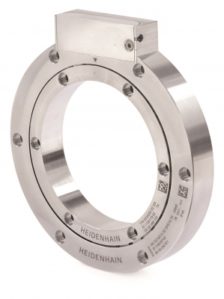Heidenhain Unveils New Hollow-Shaft Rotary Encoders at SPS IPC Drives Show

For the SPS IPC Drives 2016 trade show, Heidenhain is supplementing its existing program of inductive position encoders with its new rotary encoder series ECI 4000/EBI 4000. To be highlighted at this trade show in Nuremburg, Germany on November 22-24, the new encoder variants are modular devices without integral bearing and with a 90 mm hollow shaft. This enables the user to replace the conventional toothed-belt drive for coupling a motor feedback system to torque motors.
With fewer components, these new rotary encoders provide increased performance and guaranteed wear-free operation. Moreover, they set new standards in attainable control dynamics, reliability and functionality. In this way, they open up new applications for inductive rotary encoders, e.g. on highly dynamic motors, drive modules and machine components that require a corresponding hollow shaft in the encoder.
The singleturn version of the ECI 4000 features resolution of 20 bits. As an alternative, with its EBI 4000, Heidenhain offers a multiturn variant that features a revolution counter option with resolution of 16 bits and that is backed up by an external battery buffer. The new inductive rotary encoders consist of a scanning unit and the scale drum. With an overall height of only 20 mm, they have outstanding characteristics.
The scanning is performed through an all-round scanning. In this setup, the complete graduation structure of the scale drum (rotor) with the associated scanning band of the scanning unit (stator) is involved in obtaining the position signal. In this way, the rotary encoder evaluates two incremental scanning tracks of differing periodicity. This scanning principle has an extremely positive effect on the mounting tolerances and the positioning accuracy. Additionally, over the entire velocity range up to 6,000 rpm, it largely compensates position error arising from a rotational center offset of the measured shaft.
The new inductive rotary encoders ECI 4000 and EBI 4000 are equipped with the digital EnDat 2.2 interface. In addition to noise-free transmission, the EnDat 2.2 interface also supports further encoder-specific functions, such as the data transfer from one temperature sensor inside the encoder and one outside of it, or the allocation of standardized valuation numbers for signal diagnostics. The output of these operating parameters in the closed control loop allows permanent monitoring of the encoder status. Additional connections are possible with the DRIVE-CLiQ* interface available as an option for the singleturn version.
Certification for SIL 2 applications in compliance with EN 61508 is being planned for the encoders. By employing additional measures in the subsequent electronics, users can raise the security level of the EnDat 2.2 devices to SIL 3. The relevant fault exclusion criteria for a safe mechanical connection are of course part of the certification.
The encoders are designed for easy installation and the ability to smoothly integrate into the applications of motors and machines. Among other things, they fulfill protection class of IP40 for this. Thanks to an external and an internal centering diameter on the scanning unit and scale drum respectively, they can be mounted quickly without any special tools for adjusting and testing and immediately put into operation. An application-specific axial offset of the scale drum to the scanning unit is tolerated in a range of ±1.5 mm. The maximum drive shaft runout tolerance is similarly generous at 0.2 mm.
The operating temperature range for encoders with EnDat 2.2 interface is up to +115°C. Vibration resistance is 400 m/s² for the stator and 600 m/s² for the rotor in accordance with EN 60068-2-6. This guarantees great robustness as a motor feedback system—particularly when the motor is designed for high performance.





